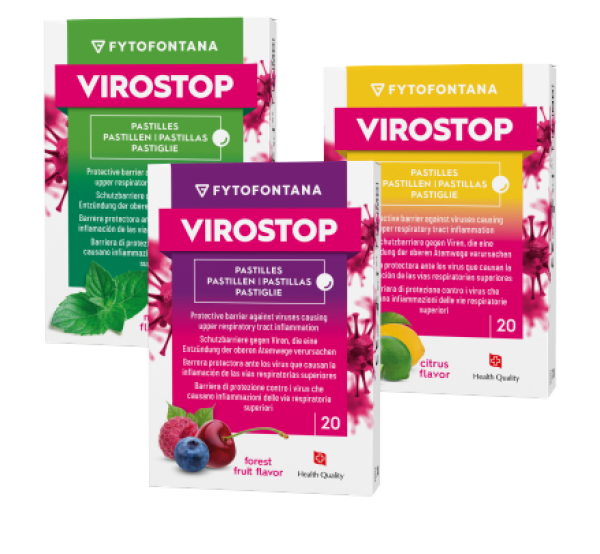Distinguishing between bacterial and viral infection is essential for proper treatment. While antibiotics work for bacterial infections, VIROSTOP can help with upper respiratory infections.
When we fall ill, it's usually impossible to immediately discern whether we've been struck by a viral or bacterial infection. Particularly, upper respiratory infections may initially appear very similar, but targeted treatment is necessary. Why is this important, and what could incorrect treatment lead to?
What is the difference between viruses and bacteria?
The difference between viruses and bacteria is quite distinct, although we can't always determine from symptoms alone whether they're caused by viruses or bacteria. Distinguishing between bacteria and viruses is, however, crucial for proper treatment.
Bacteria are cellular organisms with typical cellular components or organelles. Fortunately, their cells significantly differ from our body's cells, allowing antibiotics to directly kill or inhibit bacterial reproduction without endangering our cells.
Viruses, on the other hand, are entirely different entities. They consist solely of genetic material and a protective coat with binding sites. Using these sites, a virus enters a host cell. Essentially, it's a parasite that cannot survive long-term without a host and cannot replicate independently. Upon entering our body, it infiltrates a cell's interior, reprograms it, and compels it to produce only copies of the virus. Once assembled into new viral units, they exit the cell and attempt to infect other healthy cells within reach. Antiviral medications are developed to combat viruses, but they are typically available only by prescription. However, in the case of upper respiratory tract infections, there's an over-the-counter option to directly address them using natural substances in the VIROSTOP solution.
How can we distinguish between viral and bacterial infection in upper respiratory tract infections?
Infections of the upper respiratory tract often present very similar symptoms. A person affected by such an infection might experience a runny nose, sore throat, cough, elevated temperature up to a fever, muscle aches, headaches, or even generalized body pain. While there are instances where the severity and intensity of symptoms precisely indicate the cause, it's not always that straightforward.
In such cases, doctors resort to more or less complicated examinations and laboratory tests. The quickest and most readily available is the CRP test, which general practitioners actively use in diagnosing infections. In recent years, this test can also be self-administered at home using self-testing kits easily purchased at pharmacies.
The CRP test operates by detecting the concentration of C-reactive protein in a drop of blood. This protein is produced by our body in response to any inflammation, not just infectious ones. However, not every inflammation triggers it in the same way. It achieves high levels particularly in bacterial infections, often within a few hours from the onset of symptoms. This allows a doctor to determine within minutes whether antibiotics are necessary or not. Unnecessary use of antibiotics is linked to the development of bacterial antibiotic resistance and has a negative impact on our beneficial gut bacteria.
What is antibiotic resistance?
Can you imagine a time when humanity didn't have access to antibiotics? Common illnesses that can be easily resolved with a week-long course of tablets nowadays used to be fatal in the past. However, the excessive use of antibiotics can lead us back to a situation where our doctor won't have an effective treatment for our infection, leaving us without proper help. The development of antibiotic resistance isn't just a concern for the future; it's happening right now.
Data collected by the European Center for Disease Prevention and Control (ECDC) between 2016 and 2020 showed a dangerous fact. On average, up to 35,000 inhabitants of the European Union die annually as a result of complications due to antibiotic resistance, which means almost 100 people a day. WHO identifies antibiotic resistance as one of the biggest threats to global health and food security.
Although the development of antibiotic resistance in bacteria occurs partly naturally, we also contribute to it. We support this whole process through excessive use of antibiotics, their incorrect use for treating viral infections, and weak prevention of infection spread.
Therefore, during viral infections, do not take antibiotics or request them from your doctor. They wouldn't help anyway. Instead, we can choose to support treatment using VIROSTOP products. A significant advantage of these products is that they do not promote the development of resistance, not only in bacteria but also in viruses.
How do improperly used antibiotics affect our health?
The development of antibiotic resistance isn't the only negative impact on our health. The use of antibiotics always affects our beneficial bacteria, which support our overall health. The most significant impact is on the gut microbiome. These bacteria in the intestines significantly influence our immunity, as well as various processes in our body. While combating a bacterial infection, the damage inflicted on the microbiome by antibiotics is somewhat necessary. However, during viral infections, not only do antibiotics fail to help, but they also actively harm us.
Can we treat upper respiratory tract viral infections in ways other than just symptomatically?
According to experts, up to 90% of common upper respiratory tract infections are caused by viruses. In some cases, this viral disease is later complicated by bacteria. If this is your case, you might notice that after several days, you're not improving, and additional symptoms join your original illness, or the initial symptoms worsen again.
To prevent complications, experts recommend starting to treat viral infections properly as soon as possible, and antibiotics are not the solution. The foundation lies in bed rest, hydration, diligent clearing of airways from mucus, and alleviating symptoms.
However, in recent years, we can further support our treatment using VIROSTOP products. They contain natural extracts from up to five plants, notable for their high content of polyphenolic compounds. These compounds have the ability to directly bind to viral binding sites, blocking them. This prevents viral particles from infecting our cells and replicating. Moreover, VIROSTOP solution also alleviates respiratory illness symptoms.
It can be used not only at the onset of symptoms during an ongoing infection but also as a protection for the respiratory system during times of increased infection risk. Using it does not entail concerns about adverse effects, and the products are suitable for children from 6 years of age.







